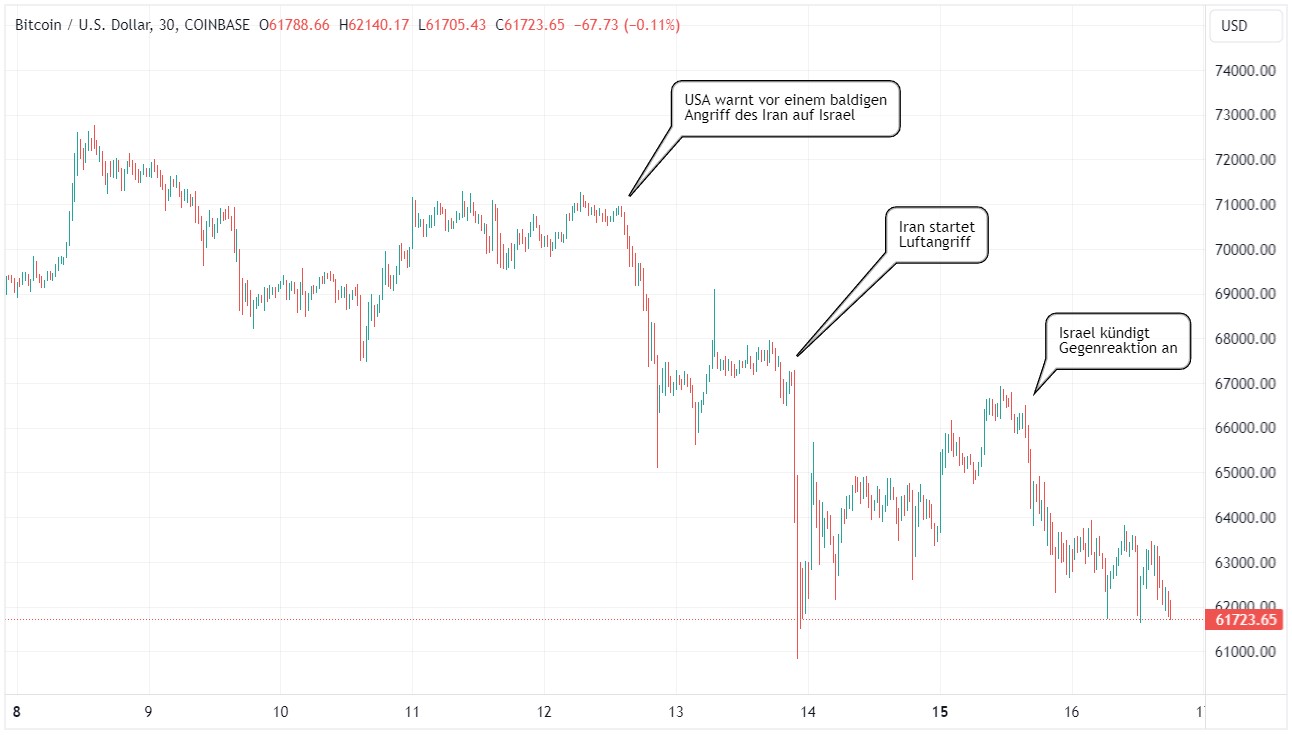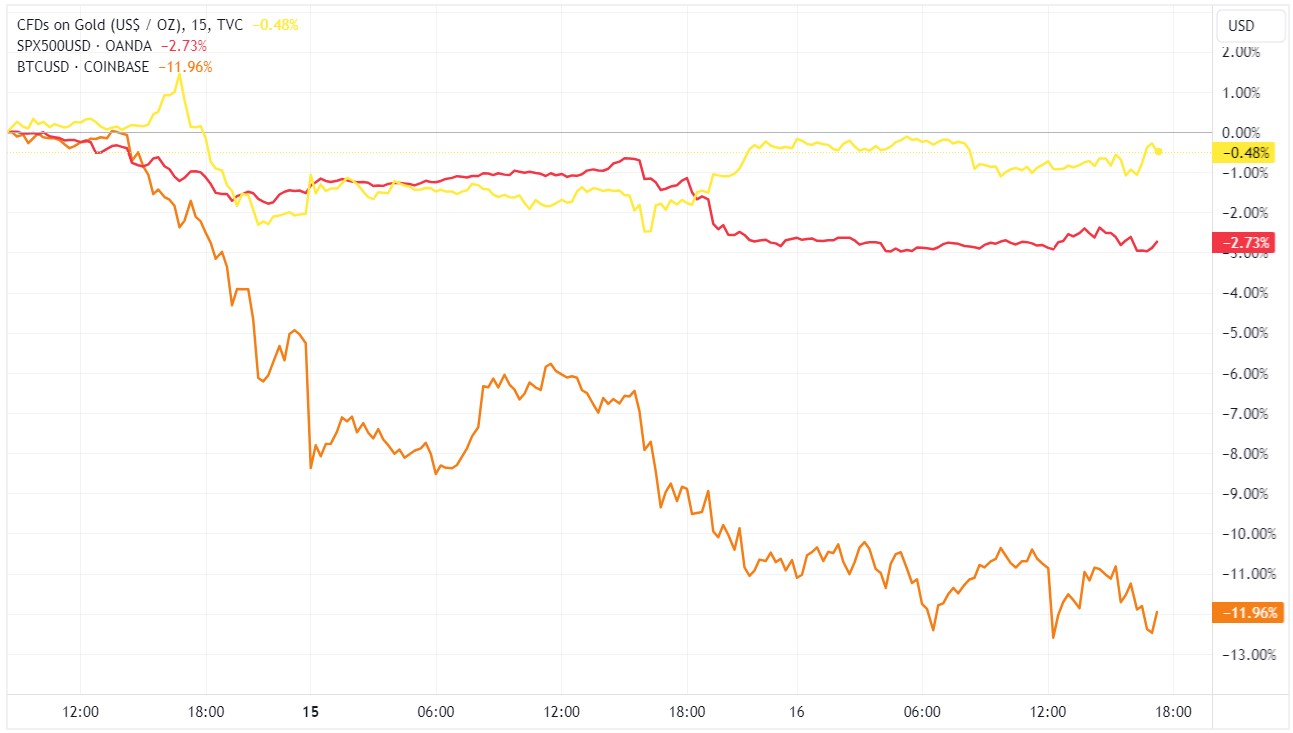Bitcoin staggers in reaction to geopolitical risks
After Bitcoin made a brilliant start to 2024, the asset has slumped significantly in recent days. The primary reason for this appears to be the escalating conflict between Iran and Israel and the resulting geopolitical uncertainties. There was a clear temporal connection between the asset's price slippage and news about the conflict.
The so-called "flash crashes" were exacerbated by the usual liquidation cascades on the market. Positions of market participants who act leveraged are forced to close if the price moves too far against expectations. This amplifies price swings in the corresponding direction.
After Bitcoin was only 1.5% away from the new all-time high of USD 73,800 set in mid-March on Monday last week, the asset is currently trading just above the USD 60,000 mark, around 20% away from its peak.
Bitcoin reacts strongly negatively to geopolitical news
Last Friday, Bitcoin fell by 8 percent within a few hours when an Iranian attack on Israel seemed much more likely. When more than 300 drones, cruise missiles and ballistic missiles were actually fired from Iran towards Israel on Saturday evening German time - almost all of which were intercepted - Bitcoin plummeted by almost 10 percent within two hours. This retaliatory strike by Iran is a reaction to the suspected Israeli attack on an Iranian embassy in Damascus, Syria.
According to data from Coinglass, trading positions worth the equivalent of almost USD 2 billion were flushed out of the entire crypto market during the price slumps on Friday and Saturday. Bitcoin accounted for around 500 million US dollars in liquidations.
After a slight recovery on Sunday and Monday morning, the asset has been trading significantly weaker again since yesterday afternoon. Israel is not planning to let the Iranian airstrike pass without consequences.
We are looking ahead and considering our steps. The firing of rockets, cruise missiles and drones into Israeli territory will be answered.
Herzi Halevi, Chief of Staff of the Israeli army
Iran, for its part, warns that it will follow up with a "severe, comprehensive and devastating" response. At present, it looks as if a further escalation is imminent, although Israel has actually announced that it wants to avoid war.
Bitcoin not a safe haven after all?
Observing the price development during such exceptional situations is highly relevant for market observers in order to be able to classify the asset appropriately. Bitcoin enthusiasts generally see Satoshi Nakamoto's creation as protection against uncertainty, as unlike almost all other asset classes, Bitcoin has no counterparty risk.
However, some market participants still seem to treat Bitcoin as a so-called risk-on asset, which they sell off in crisis situations. This classification is also supported by the fact that Bitcoin lost half its value in two days during the coronavirus crash in 2020 - around two months before the halving. When Russia attacked Ukraine on February 24, 2022, Bitcoin also fell slightly, but recovered by more than 20% from its low point within a few days. In response to the banking crisis in 2023, Bitcoin again rose significantly after the asset had also briefly collapsed.
And when Bitcoin recorded strong price gains in the days following the Hamas attack on Israel, BlackRock CEO Larry Fink spoke of a "flight to quality" in this context. Accordingly, the past does not yet allow a final conclusion to be drawn as to whether Bitcoin is a risk-on or risk-off asset.
In the current geopolitical uncertainty, not only the stock markets are weakening alongside Bitcoin, but also the supposed crisis metal gold. Nevertheless, Bitcoin has recorded by far the biggest price losses against these asset classes, while gold has held up best.
Headwinds despite positive news
Bitcoin is weakening, although the halving is due in a few days. In the past, this event, in which the number of new Bitcoin added per block is halved, has always led to strong price gains in the following weeks and months. The explanation for this is that less new BTC comes into circulation to meet the organic buying demand.
In addition, yesterday also saw the listing of Bitcoin spot ETFs on the Hong Kong Stock Exchange, which is one of the largest in the world. The Bitcoin-based investment products are expected to celebrate their first day of trading in the Chinese Special Administrative Region in the near future.
Bitcoin spot ETFs from the US have seen only minor outflows over the past two trading days, when the price corrected, totaling just over USD 90 million. The cumulative inflows since admission in January of this year are thus still stagnating at a high level and BlackRock's ETF is continuing to extend the longest active streak of days on which a fund has soaked up capital.
No reason to panic
As Bitcoin's weakness is not due to fundamental problems, panic is probably inappropriate at this point. Not least because strong corrections in the asset are normal even in bull markets. If the geopolitical situation calms down soon - as would of course be desirable from a humanitarian perspective - a strong recovery in the Bitcoin price is also not unlikely.
Whether and when the majority of the market will realize that Bitcoin is the real safe haven due to its many positive characteristics is written in the stars. Michael Saylor, the founder of the Bitcoin-based company MicroStrategy, emphasized once again in the context of the current uncertainties that no crisis can actually harm Bitcoin.
Chaos is good for #Bitcoin
- Michael Saylor⚡️ (@saylor) April 13, 2024







